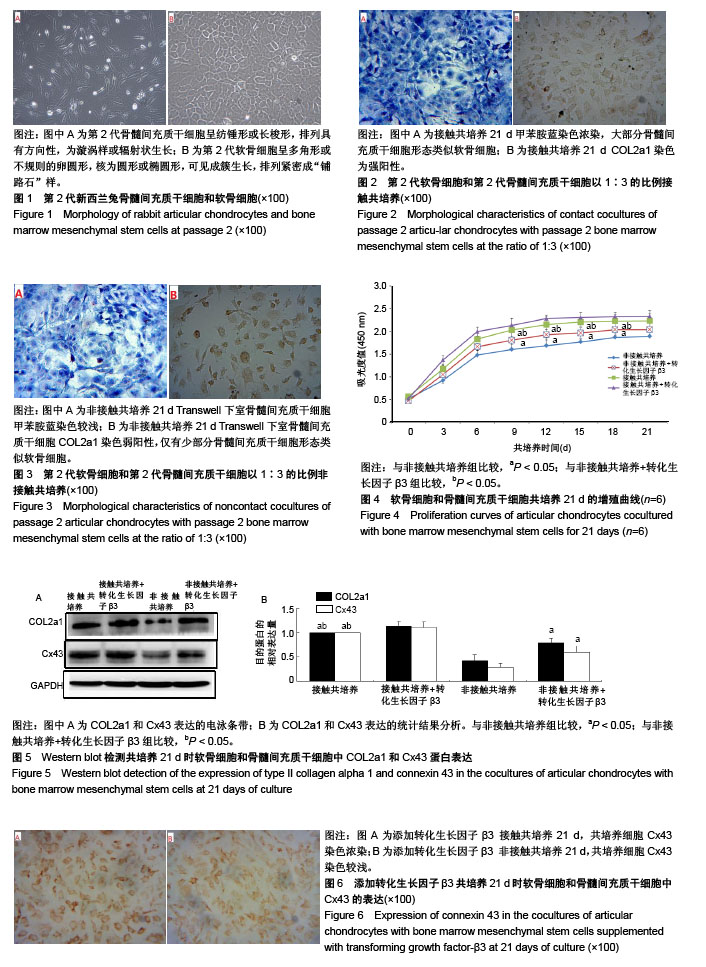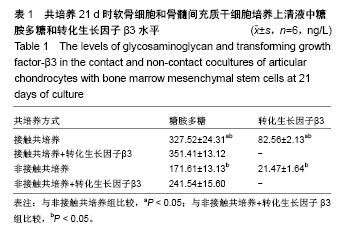| [1] Ko CY, Ku KL, Yang SR, et al. In vitro and in vivo co-culture of chondrocytes and bone marrow stem cells in photocrosslinked PCL-PEG-PCL hydrogels enhances cartilage formation. J Tissue Eng Regen Med. 2016;10(10):E485-E496.[2] Acharya C, Adesida A, Zajac P, et al. Enhanced chondrocyte proliferation and mesenchymal stro-mal cells chondrogenesis in coculture pellets mediate improved cartilage formation. J Cell Physiol. 2012;227(1):88-97.[3] 冯万文,莱浙军,李小民,等.骨髓间充质干细胞和软骨细胞共培养种子细胞特征及体内成软骨活性[J].中国组织工程研究与临床康复, 2008,12(3): 442-446.[4] Bian L, Zhai DY, Mauck RL, et al. Coculture of human mesenchymal stem cells and articular chondrocytes reduces hypertrophy and enhances functional properties of engineered cartilage. Tissue Eng Part A. 2011;17(7-8):1137-1145.[5] Steck E, Fischer J, Lorenz H, et al. Mesenchymal stem cell differentiation in an experimental cartilage defect: restriction of hypertrophy to bone-close neocartilage. Stem Cells Dev. 2009;18(7): 969-978.[6] 冯万文,夏亚一,孙正义,等.骨髓间充质干细胞和软骨细胞共培养复合同种异体脱钙骨基质修复关节软骨全层缺损[J].第四军医大学学报, 2006, 27(18):1683-1686.[7] Zuo Q, Cui W, Liu F, et al. Co-cultivated mesenchymal stem cells support chondrocytic differentiation of articular chondrocytes. Int Orthop. 2013;37(4):747-752.[8] Kang N, Liu X, Yan L, et al. Different ratios of bone marrow mesenchymal stem cells and chon-drocytes used in tissue-engineered cartilage and its application for human ear-shaped substitutes in vitro. Cells Tissues Organs. 2013;198(5):357-366.[9] 陈宗雄,刘晓强,王万宗.骨髓间充质干细胞和关节软骨细胞共培养与转化生长因子β1诱导的比较[J].中国组织工程研究与临床康复, 2010,14(27): 5037-5040.[10] Wu L, Leijten JC, Georgi N, et al. Trophic effects of mesenchymal stem cells increase chondro-cyte proliferation and matrix formation. Tissue Eng Part A. 2011;17(9-10):1425-1436.[11] Meretoja VV, Dahlin RL, Kasper FK, et al. Enhanced chondrogenesis in co-cultures with articu-lar chondrocytes and mesenchymal stem cells. Biomaterials. 2012;33(27):6362-6369. [12] Yao Y, Huang Y, Qian D, et al. Effect of Various Ratios of Co-Cultured ATDC5 Cells and Chondrocytes on the Expression of Cartilaginous Phenotype in Microcavitary Alginate Hydrogel. J Cell Biochem. 2017;118(11):3607-3615.[13] Knight MM, McGlashan SR, Garcia M, et al. Articular chondrocytes express connexin 43 hemi-channels and P2 receptors - a putative mechanoreceptor complex involving the primary cilium. J Anat. 2009; 214(2):275-283.[14] Mayan MD, Carpintero-Fernandez P, Gago-Fuentes R, et al. Human articular chondrocytes ex-press multiple gap junction proteins: differential expression of connexins in normal and osteoarthritic cartilage. Am J Pathol. 2013;182(4):1337-1346.[15] Zhang X, Sun Y, Wang Z, et al. Up-regulation of connexin-43 expression in bone marrow mes-enchymal stem cells plays a crucial role in adhesion and migration of multiple myeloma cells. Leuk Lymphoma. 2015;56(1):211-218.[16] De Windt TS, Saris DB, Slaper-Cortenbach IC, et al. Direct Cell-Cell Contact with Chondrocytes Is a Key Mechanism in Multipotent Mesenchymal Stromal Cell-Mediated Chondrogenesis. Tissue Eng Part A. 2015;21(19-20):2536-2547.[17] Yang YH, Lee AJ, Barabino GA. Coculture-driven mesenchymal stem cell-differentiated articu-lar chondrocyte-like cells support neocartilage development. Stem Cells Transl Med. 2012;1(11):843-854.[18] Dahlin RL, Ni M, Meretoja VV, et al. TGF-β3-induced chondrogenesis in co-cultures of chon-drocytes and mesenchymal stem cells on biodegradable scaffolds. Biomaterials. 2014;35(1):123-132.[19] Chen FM, Zhang M, Wu ZF. Toward delivery of multiple growth factors in tissue engineering. Biomaterials. 2010;31(24):6279-6308.[20] Dahlin RL, Meretoja VV, Ni M, et al. Chondrogenic phenotype of articular chondrocytes in monoculture and co-culture with mesenchymal stem cells in flow perfusion. Tissue Eng Part A. 2014;20(21-22):2883-2891.[21] Schrobback K, Klein TJ, Woodfield TB. The importance of connexin hemichannels during chondroprogenitor cell differentiation in hydrogel versus microtissue culture models. Tissue Eng Part A. 2015;21(11-12): 1785-1794.[22] Willebrords J, Maes M, Crespo Yanguas S, et al. Inhibitors of connexin and pannexin channels as potential therapeutics. Pharmacol Ther. 2017;180:144-160.[23] Zhang YD, Zhao SC, Zhu ZS, et al. Cx43- and Smad-Mediated TGF-β/ BMP Signaling Pathway Promotes Cartilage Differentiation of Bone Marrow Mesenchymal Stem Cells and Inhibits Osteoblast Differentiation. Cell Physiol Biochem. 2017;42(4):1277-1293. |
.jpg)


.jpg)